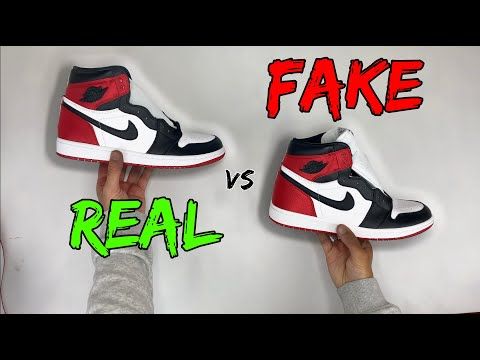With the popularity of Jordan sneakers skyrocketing over the years, the market has seen a significant rise in counterfeit products. As a sneaker enthusiast or a casual buyer, distinguishing between genuine and fake Jordans is crucial to ensure you get what you pay for. This comprehensive guide will walk you through various methods to help you identify counterfeit Jordans and make informed purchasing decisions. We’ll cover checking the box and style number, inspecting the shoe construction, being aware of selling practices, and other useful methods to spot fake Jordans.
METHODS:
1. Checking the Box and Style Number

Examine the Box
One of the first things to look at when verifying the authenticity of a pair of Jordans is the box. Authentic Jordans come in high-quality boxes with clear, well-printed labels. Here’s what you should check:
- Material and Build Quality: Genuine Jordan boxes are made of sturdy cardboard that doesn’t easily dent or deform. The print should be sharp and not faded or blurry.
- Logo and Branding: The Jumpman logo and other branding elements on the box should be crisp and accurately represented. Any deviation in the logo design is a red flag.
- Box Lid and Fit: The lid of the box should fit snugly without gaps. The edges should be clean and not rough or uneven.
Style Number and Label
Each pair of Jordans has a unique style number that corresponds to the specific model and colorway.
- Match the Style Number: Look for the style number on the box label and compare it with the style number found on the inside of the shoe. You can usually find this number on the tongue label or inside the shoe. The numbers should match exactly.
- Verify on Official Sites: Cross-check the style number on Nike’s official website or trusted sneaker databases to ensure it matches the correct model and colorway.
- Label Details: The label should include the size, country of manufacture, and a barcode. Check for any spelling mistakes, uneven text, or poor-quality printing.
2. Inspecting the Shoe Construction

Material Quality
The quality of materials used in authentic Jordans is one of the most telling signs of their authenticity.
- Leather and Fabric: Genuine Jordans use high-quality leather and fabrics that feel premium to the touch. Fake pairs often use cheaper, lower-quality materials that can feel stiff or plasticky.
- Sole and Midsole: The soles of real Jordans are made with durable rubber and have precise, clean lines. Check for any excess glue or uneven stitching around the sole and midsole area.
Stitching and Craftsmanship
Attention to detail is a hallmark of genuine Jordan’s.
- Stitching: The stitching on authentic Jordans is uniform, tight, and evenly spaced. Look for any loose threads or uneven stitching, which can indicate a fake.
- Logo Placement: Inspect the placement of logos and other branding elements. The Jumpman logo, in particular, should be perfectly proportioned and accurately positioned.
Insole and Inner Workings
The inside of the shoe can also provide clues about its authenticity.
- Insole Quality: Genuine Jordans have high-quality insoles with proper cushioning. The branding on the insole should be clear and well-printed.
- Inner Tag: The inner tag should include detailed information like the style number, size, and production date. Compare this information with the box label for consistency.
3. Being Aware of Selling Practices

Authorized Retailers
Purchasing from authorized retailers is one of the best ways to ensure you’re getting authentic Jordans.
- Official Retailers: Buy from Nike’s official website, authorized retailers, or well-known sneaker boutiques. Avoid shady online stores or unknown sellers.
- Receipts and Documentation: Always ask for a receipt and any official documentation that comes with the shoes. This can help verify the purchase’s authenticity.
Price Too Good to Be True
If the deal seems too good to be true, it probably is.
- Market Value: Be aware of the current market value of the Jordans you’re interested in. Prices significantly lower than retail or resale market value are a major red flag.
- Discounts and Sales: While sales and discounts happen, they are rare for highly sought-after models. Be cautious of substantial markdowns from unknown sellers.
Seller Reviews and Reputation
Researching the seller’s reputation can provide insights into the likelihood of receiving authentic products.
- Customer Reviews: Check customer reviews and ratings on platforms like eBay, Amazon, or other online marketplaces. Positive feedback from previous buyers can be reassuring.
- Return Policy: A genuine seller will offer a clear return policy. If the return policy is vague or non-existent, it’s best to avoid that seller.
4. Additional Methods to Spot Fake Jordans
Smell Test
Believe it or not, the smell can be an indicator of authenticity.
- Chemical Odor: Fake Jordans often have a strong chemical smell due to the use of cheap materials and adhesives. Authentic Jordans typically have a mild, fresh smell from the premium materials used.
Weight Comparison
The weight of the shoes can also be a clue.
- Heavier Shoes: Authentic Jordans usually weigh more because of their high-quality materials and construction. Fake Jordans might feel lighter due to cheaper materials.
UV Light Test
Using a UV light can help reveal hidden details.
- Authenticity Marks: Some authentic Jordans have UV marks or features that are only visible under UV light. This is a more advanced method but can be very effective.
Comparison with Authentic Pairs
If you have access to a confirmed authentic pair, use it for comparison.
- Side-by-Side Comparison: Compare the fake and authentic pairs side by side, noting differences in color, texture, and construction quality.
5. Seeking Professional Authentication Services
Expert Services
For high-value purchases, consider using professional authentication services.
- Sneaker Authentication Services: Services like StockX, GOAT, or Sneaker Con offer authentication services where experts verify the authenticity of the shoes.
- Local Sneaker Stores: Some local sneaker stores also provide authentication services for a fee.
6. Online Resources and Communities
Sneaker Forums and Communities
Joining sneaker forums and online communities can provide valuable insights.
- Community Feedback: Platforms like Reddit, NikeTalk, and Sole Collector have active communities where members share their experiences and tips on spotting fake Jordans.
- Authenticity Guides: Many community members create detailed guides with photos comparing fake and authentic pairs, which can be incredibly useful.
Social Media and Influencers
Following trusted sneaker influencers and reviewers on social media can keep you updated on the latest trends and counterfeit warnings.
- Influencer Reviews: Influencers often review new releases and share tips on spotting fakes, helping you stay informed.
Conclusion
Spotting fake Jordans requires a keen eye and attention to detail. By following the methods outlined in this guide, you can significantly reduce the risk of purchasing counterfeit Jordans. Always start by checking the box and style number, inspect the shoe construction meticulously, and be aware of suspicious selling practices. Additionally, utilizing other methods like the smell test, weight comparison, UV light test, and seeking professional authentication services can further ensure the authenticity of your purchase. Engaging with online resources and communities can also provide continuous learning and support. With these tools at your disposal, you can confidently navigate the sneaker market and make informed decisions. Happy sneaker hunting!
Frequently Asked Questions:
- How can I check if the style number on my Jordans is authentic?
Verify the style number on the inside label of the shoe and the box label. Ensure they match exactly. Cross-check the style number on Nike’s official website or trusted sneaker databases to confirm it corresponds to the correct model and colorway.
- What are the common signs of poor shoe construction in fake Jordans?
Common signs of poor construction include uneven stitching, excess glue, and low-quality materials. Authentic Jordans have a uniform, tight stitching, clean lines around the sole and midsole, and premium materials that feel high-quality.
- Can the price of Jordans indicate if they are fake?
Yes, if the price is significantly lower than the retail or market value, it might indicate a fake. Be cautious of deals that seem too good to be true, as genuine Jordans, especially limited editions, rarely have substantial markdowns.
- Are there any professional services that can authenticate my Jordans?
Yes, services like StockX, GOAT, and Sneaker Con offer professional authentication. Some local sneaker stores also provide authentication services for a fee. Using these services can give you confidence in the authenticity of your Jordans.
- 21 Delicious High Protein Foods - May 31, 2024
- Black Seed Oil: Health and Beauty Benefits - May 30, 2024
- 260 ‘Would You Rather’ Questions: Know Friends Better! - May 29, 2024


